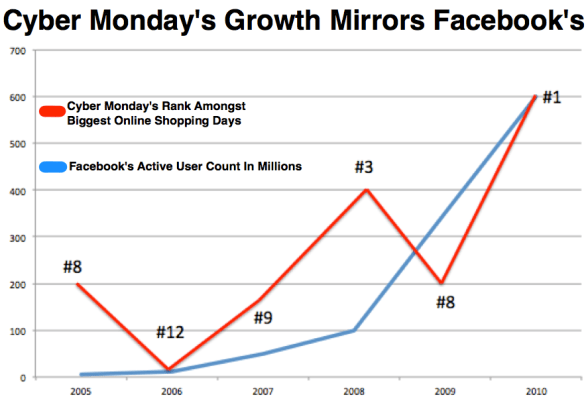Editor’s note: Scott Silverman is the co-founder and VP of Marketing for Ifeelgoods, Inc., a digital goods incentive platform. Prior to Ifeelgoods, Silverman spent more than 10 years as Executive Director of Shop.org and is one of the creators of Cyber Monday. You can follow him @scottsilverman.
When the term Cyber Monday was coined in 2005, the Monday after Thanksgiving was the 12th biggest online shopping day of the year. That year, Facebook had 5.5 million users and Twitter didn’t exist. In 2010, Cyber Monday was the #1 biggest online shopping day of the year, with sales topping $1 billion. I believe the growth of social media and the importance of Cyber Monday are correlated because peer -to-peer sharing of deals and owned marketing channels like Facebook Pages and Twitter accounts are bringing promotions directly to where users spend their time online.
The red line is where Cyber Monday ranked among the top online shopping days (from comScore press releases) for that year. Aside from 2008, which is an outlier due the recession, there is a trend in Cyber Monday popularity growing along with Facebook users.
As background, Cyber Monday was coined in 2005 by e-commerce industry group Shop.org while I was its executive director. The trend was identified through data from online retailers who in in previous years had seen spikes in sales the Monday after Thanksgiving. It seems that people go online to continue their post-Black Friday shopping for items they didn’t buy, perhaps because they wanted to research them more thoroughly or buy them out of the sight of the intended recipient.
There is an argument about the impact of social media on retail sales. Some are skeptical, saying social isn’t as effective as email marketing or paid search advertising for customer acquisition. Others think the shift to social advertisements and viral marketing is just starting to take off. The debate will surely continue as researchers struggle to identify the perfect science for measuring its effect. Ironically, data about the impact of TV and radio ads remains just as elusive, yet broadcast advertising continues to command a disproportionate amount of spending.
But retailers are successfully building their presences on social networks. The 25 U.S. retailers with the most fans on Facebook had a combined 259 million fans in October. During the holiday season, these fans will find deals from retailers who’ve invested in social. Retailers hesitant about social will be less likely to attain sales from these users as their competitors profit.
According to Shop.org, 29 percent of consumers will check out a retailer’s Facebook page as part of their online holiday shopping this year. Of course, these are just the people who say they’ll seek out this information and it doesn’t take into account the number of people that will see sales and promotions from retailers in their news feed.
Data aside, there is no question that social media is having a profound impact on the way we shop. Today, we depend on our social networks to tip us off to the best deals and sales. Only two or three years ago this was not the case.
